Republican Guard (France)
| Garde républicaine | |
|---|---|
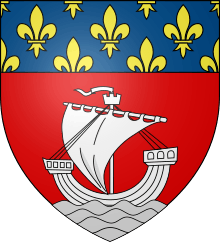 | |
| Active | 1848–present |
| Country |
|
| Branch | National Gendarmerie |
| Type |
Infantry, Cavalry |
| Role |
Honour Guard, Security |
| Size | 2,800 |
| Garrison/HQ | Paris |
| Decorations |
|
The Republican Guard (French: Garde républicaine) is part of the French Gendarmerie. It is responsible for providing guards of honor for the State and security in the Paris area.
Its missions include:
- Guarding important public buildings in Paris such as the Élysée Palace (the residence of the President of the French Republic), the Hôtel Matignon (the residence of the Prime Minister of France), the Palais du Luxembourg (the Senate), the Palais Bourbon (the National Assembly), the Palais de Justice, and keeping public order in Paris.
- Honor and security services for the highest national personalities and important foreign guests;
- Military ceremonies and guards of honour for fallen soldiers.
- Support of other law enforcement forces with intervention teams;
- Staffing horseback patrol stations, particularly for the forests of the Île-de-France region;
The close physical protection of the President of France is entrusted to the Groupe de sécurité de la présidence de la République (GSPR) a mixed police–gendarmerie unit which is not part of the Guard. The Guard however provides counter-sniper teams (observateurs-contre-tireurs) and intervention platoons (pelotons d'intervention).
The Republican Guard also represents France at international events at home or abroad. It is twinned with the Red Guard of Senegal.[1]
History
.jpg)

The Republican Guard is the heir of the various bodies that preceded it in the course of French history and whose task was to honor and protect the high authorities of the State and City of Paris : Gardes Françaises of the Kings, Consular and Imperial guard of Napoleon, etc.. Its name derives from the Municipal Guard of Paris, established on 12 Vendémiaire XI (October 4, 1802) by Napoleon Bonaparte. It distinguished itself in battles of historical significance, including Danzig and Friedland in 1807, Alcolea in 1808 and Burgos in 1812.
In 1813 it was dissolved following the attempted coup of General Malet and replaced by the Imperial Gendarmerie of Paris and then, under the Restoration, the Royal Guard of Paris and the Royal Mounted Police of Paris. In 1830, it was recreated, and again removed after the Revolution of 1848 in favor of the Civic Guard (which proved to be a transient institution).
June 1848 saw the creation of the Republican Guard of Paris, including an infantry regiment and a regiment of cavalry. On February, 1 1849, a Napoleon III decree made the Guard a part of the French National Gendarmerie. It received its insignia July 14, 1880. It didn't take part in the First World War as a unit but more than one third of its personnel were seconded to Army regiments for the duration of the conflict. As a consequence, its flag and banner decorated with the Knight's Cross of the Legion of Honour. During the Second World War, it reported to the police headquarters and took the name of Guard of Paris. Part of its staff rallied to General de Gaulle and the Guard was involved in the fighting alongside the FFI during the liberation of Paris.
In 1952, the guard was renamed the Legion of the Republican Guard of Paris and took part in the Indochina War, which earned it the Croix de Guerre.
In 1978, the guard took its current name of "Republican Guard." President Giscard d'Estaing gave it, on 11 November 1979, its new insignia. Michele Alliot-Marie, Minister of Defence, said in October 2002: "The Republican Guard has a popularity that transcends borders," it contributes "to the splendour of the French military and France."[2]
Missions
Ceremonial duties
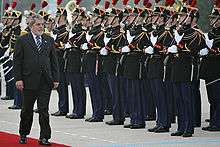
These ceremonial functions are performed mainly by the first infantry regiment, the cavalry regiment and occasionally by the second infantry regiment.
Detachments from the cavalry regiment reinforce the two infantry regiments in carrying out ceremonial and security duties in and around state buildings. These include the lining of both sides of the entry stairs of the Elysée or Matignon Palaces (and other buildings) by dismounted cavalry on special occasions. These Republican Guards belong to the Cavalry Regiment and not to the infantry units whose mission is to ensure the security of these palaces and of senior government figures. Certain ceremonial duties in the form of honour guards are performed when state visits are made to the Paris museums or the Opera, as well as other ceremonies (for example at the French Academy).[3]
Security missions
Although the ceremonial duties attract more public attention, more than 80% of the missions assigned to the Garde are security missions. These include missions performed for the state such as protection of state buildings but also missions performed for the benefit of the population (for example patrols in the parks and streets).
- Security missions

Guard counter-snipers (observateurs-contre-tireurs)  Mounted guards in service dress patrolling near the Louvre
Mounted guards in service dress patrolling near the Louvre Escorting a rider demonstration in Paris
Escorting a rider demonstration in Paris Guard intervention team (peloton d'intervention)
Guard intervention team (peloton d'intervention)
Other missions
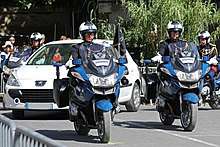
Some guards are assigned to more specific missions:
- Security of diplomatic bags entering and leaving the Ministry for Foreign Affairs and the airports.
- Safety of sport events such as the Tour de France cyclist race by the motorcycle squadron.
- Reinforcement and support to the Departmental Gendarmerie
- Assistance and coopereration in foreign countries and especially in former French colonies.
Organization
The Republican Guard belongs to the French National Gendarmerie. It is made up of approx. 2,800 men and women (drawn from an overall body of 100,000 gendarmes). As a historically Parisian organization, the guards wear the armorial bearings of the city on their uniforms.
It consists of two infantry regiments (one includes a motorcycle squadron) and a horse cavalry regiment. It also has four musical formations, as well as display teams demonstrating prowess in horseback or motorcycle maneuvers. The Guard is commanded by a general de division (major general). It is headquartered in the Quartier des Célestins,[4] Paris, built in 1895-1901, designed by the renowned French architect Jacques Hermant.
Cavalry regiment
.jpg)
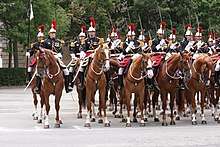
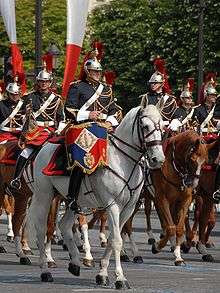
Headquartered in the Quartier des Célestins, and Quartier Carnot barracks the cavalry regiment is made up of approx. 480 gendarmes and civilians of which a little more than 10% are women. It has approximately 550 horses (11% mares) and remains the last mounted regiment in the French armed forces.
The regiment is composed of:
- Three squadrons[5] of cavalry (the first is based at Quartier des Célestins, in Paris, and two others based at Quartier Carnot, also in Paris at the fringe of Bois de Vincennes),
- Reserve squadron
- A squadron hors rang (based at Les Célestins) and composed of:
- mounted band
- horse-shoeing (farriers),
- veterinary service.
- The training centre (centre d'instruction) at Quartier Goupil Saint-Germain-en-Laye),
This unit has a section of high level sportsmen, in particular Hubert Perring, dressage champion of France in 2005, and member of the French team for the World Equestrian Games of 2006.
The Guard Cavalry Regiment is twinned with the British Household Cavalry Mounted Regiment, the Italian Carabinieri Cavalry Regiment and the Senegalese Red Guard.
Special displays of the cavalry regiment
Exhibition drill squads present four shows and reenactments:
- le carrousel des lances (the lancer's carrousel);
- la maison du Roy (the King's household cavalry);
- la reprise des tandems (the tandem riders);
- la reprise des douze (demonstration/lesson with 12 riders);
- Special displays of the cavalry regiment
 The lancer's carrousel
The lancer's carrousel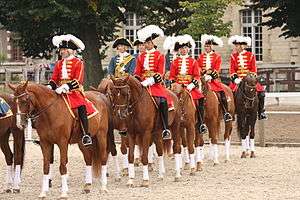 La Maison du Roy reenactment
La Maison du Roy reenactment The tandem riders
The tandem riders Public security demonstration team
Public security demonstration team
Infantry regiments
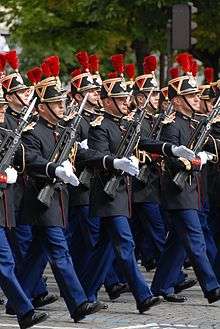
The Republican Guard has two regiments of infantry:
- The first infantry regiment is composed of :
- The Republican Guard Band and Bugles (military band and fanfare battery unit)
- Motorcycle squadron
- Compagnie de sécurité de la Présidence de la république (presidential palace security company)
- Three compagnies de sécurité et d'honneur (security and honor companies)
- the second regiment of infantry is composed of :
- Compagnie de sécurité de l'Hôtel Matignon (prime minister security company)
- Compagnie de sécurité des palais nationaux (CSPN) (national palaces security company; i.e., national assembly and senate)
- Four compagnies de sécurité et d'honneur (CSH)
- Auxiliary platoon.
Each of the seven security and honor companies is composed of three regular sections (i.e., platoons) and one peloton d'intervention (intervention platoon). The regular sections perform ceremonial duties and guards. The intervention platoons provide special security in the government buildings and palaces protected by the Guard. They are also tasked with police missions in support of the Gendarmerie in the Paris area (home arrests, escorts etc.). One of the seven intervention platoons is permanently deployed to French Guiana on a rotational basis in support of forces combating illegal gold mining.
Special displays of the infantry regiments
- Bayonet drill team (quadrille des baïllonnettes; 1st régiment)
- The battery fanfare band
- The Napoleonic brass fanfare band, wearing uniforms of the Napoleonic Wars
- Emperor's grenadiers company, serving as a reenacting unit (2nd régiment)
- Motorcycle display teams
- Special displays of the infantry regiments
 Quadrille des baïonnettes
Quadrille des baïonnettes Les grenadiers de l'Empereur reenactment company
Les grenadiers de l'Empereur reenactment company Carrousel motocycliste
Carrousel motocycliste Équipe d'acrobatie
Équipe d'acrobatie
Band and Orchestra of the Republican Guard

Depending on needs, the orchestra performs in three configurations:
- the concert band (80 musicians)
- the string orchestra (40 musicians), likely to be presented in configurations of 24 or 12 bows, or in string quartets
- Symphony orchestra (80 musicians)
It was founded in 1848 by Jean-Georges Paulus.
Chœur de l'Armée française (Armed Forces Choir)
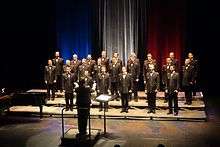
This men's choir is composed of 46 professional singers. In spite of its name (Choir of the French army), it is part of the Garde républicaine and thus reports to the Gendarmerie and through the Ministers of the Armed Forces and Interior (owing to the military character of the service). The choir performs mainly during official ceremonies and commemorations but also during festivals and sport events of national and international importance. Since 2007, it has been led by a woman, Major Aurore Tillac, who serves as choir master and director.
Commanders of the Republican Guard
- 1813–1815: Colonel Bourgeois
- 1815–1815: Colonel Colin
- 1815–1819: Colonel Tassin
- 1819–1820: Colonel Christophe de la Motte Guerry
- 1820–1822: Colonel Tassin
- 1822–1830: Colonel Foucaud of Malembert
- 1830–1831: Colonel Girard
- 1831–1839: Colonel Feisthamel
- 1839–1843: Colonel Carrelet
- 1843–1848: Colonel Lardenois
- 1848–1849: Colonel Raymond
- 1849–1849: Colonel Lanneau
- 1849–1852: Colonel Gastu
- 1852–1855: Colonel Tisserand
- 1856–1858: Colonel Texier of the Pommeraye
- 1859–1862: Colonel Faye
- 1862–1868: Colonel Letellier-Blanchard
- 1868–1870: Colonel Valentine
- 1870–1873: General Valentin
- 1873–1875: Colonel Allavene
- 1875–1875: Colonel Grémelin
- 1875–1877: Colonel Lambert
- 1877–1881: Colonel Guillemois
- 1881–1886: Colonel Azaïs
- 1886–1889: Colonel Massol
- 1889–1894: Colonel Mercier
- 1894–1895: Colonel Risbourg
- 1895–1897: Colonel De Christen
- 1897–1899: Colonel Quincy
- 1899–1902: Colonel Prevot
- 1902–1903: Colonel Doutrelot
- 1903–1904: Colonel Weick
- 1904–1909: Colonel Bouchez
- 1909–1910: Colonel Vayssière
- 1910–1914: Colonel Klein
- 1914–1917: Colonel Brody
- 1917–1917: Colonel Lanty
- 1917–1918: Colonel Brione
- 1918–1922: Colonel Somprou
- 1922–1924: Colonel Pacault
- 1924–1926: Colonel Verstraete
- 1926–1928: Colonel Miquel
- 1928–1930: Colonel Moinier
- 1930–1935: Colonel Gibaux
- 1935–1936: Colonel Maze
- 1936–1938: Colonel Durieux
- 1938–1941: Colonel Ruel
- 1941–1943: Colonel Martin
- 1943–1944: Colonel Pellegrin
- 1944–1944: Colonel Charollais
- 1944–1944: Lt-Colonel FFI Chapoton
- 1944–1944: Colonel Houllier
- 1944–1945: Lt-Colonel Heurtel
- 1945–1948: Colonel Gauduchon
- 1948–1953: Colonel Nicolini
- 1953–1957: Colonel Pelabon
- 1957–1959: Colonel Dorin
- 1959–1961: Colonel Bouchardon
- 1961–1964: Colonel Gérard
- 1964–1969: General Dumont
- 1969–1970: Colonel Chevrot
- 1970–1976: General Herlem
- 1976–1980: General Staff
- 1980–1984: General de la Rochelambert
- 1984–1986: General Depardon
- 1986–1988: General Hedgehog
- 1988–1991: General Kretz
- 1991–1995: General Lorant
- 1995–1998: General Villermain-Lecolier
- 1998–2000: General Puyou
- 2000–2002: General Prigent
- 2002–2004: General Schott
- 2004–2007: General Poupeau
- 2007–2010: Major General Moulinié
- 2010–2014: Schneider Divisional General
- 2014 onwards: Major General Striebig
Gallery
 Cavalry of the French Republican Guard - Bastille Day 2008 celebrations
Cavalry of the French Republican Guard - Bastille Day 2008 celebrations The 1st infantry regiment of the Republican Guard during Bastille day
The 1st infantry regiment of the Republican Guard during Bastille day Guard motocycliste escort
Guard motocycliste escort Quartier des Célestins barracks and RG headquarters
Quartier des Célestins barracks and RG headquarters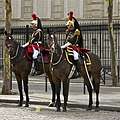 Guard (left) and officer (right) of the mounted Republican Guard
Guard (left) and officer (right) of the mounted Republican Guard
See also
References
- ↑ "Archived copy". Archived from the original on 2011-07-18. Retrieved 2011-08-27.
- ↑ fr:Garde républicaine (France)#Histoire
- ↑ Citizens could even hire Republican Guards for private fashionable evenings but this option was terminated by President Giscard d'Estaing in the mid 1970s.
- ↑ Quartier is used for barracks housing cavalry and other mounted troops while caserne is used for infantry, engineers and non-mounted troops.
- ↑ A French escadron is equivalent to a US troop or a British squadron.
External links
| Wikimedia Commons has media related to Garde républicaine (France). |